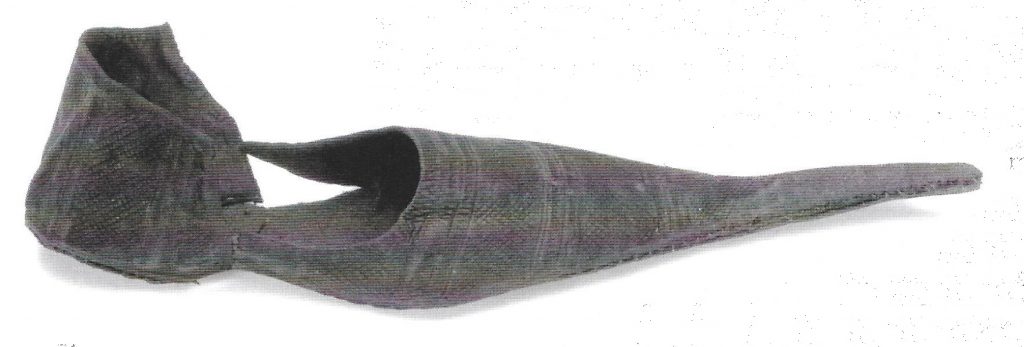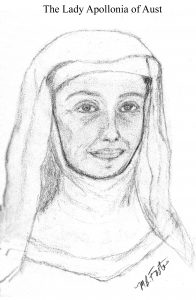 The fifth chapter of Ian Mortimer’s book, The Time Traveller’s Guide to Medieval England, is entitled: What to Wear. It deals with what people wore in 14th century England. To my surprise, that century brought more change in clothing for men than any other century, before or since, and more for women than any earlier century. Two important factors occurred about a third of the way through the century. One was the way that a sleeve was cut, allowing clothes to be tailored to the shape of the human body. The other was the use of the button to fasten garments.
The fifth chapter of Ian Mortimer’s book, The Time Traveller’s Guide to Medieval England, is entitled: What to Wear. It deals with what people wore in 14th century England. To my surprise, that century brought more change in clothing for men than any other century, before or since, and more for women than any earlier century. Two important factors occurred about a third of the way through the century. One was the way that a sleeve was cut, allowing clothes to be tailored to the shape of the human body. The other was the use of the button to fasten garments.
At the beginning of the 14th century, there was little difference in how men and women dressed. Clothes hung in a shapeless manner. Tailoring began to give shape to what one wore which meant that differences naturally arose in how the sexes dressed, and this change affected men’s clothes even more than women’s, because women were more restricted in how much of their skin could be displayed. Essentially, women could do what they liked from the neck upwards whereas men were free to display ankles and legs. Thus, masculine hems in the 14th century went up and down much like women’s fashions in the 20th century.
People in the affinity or household of a noble person often wore the livery of that household which included the heraldry of the lord or lady on their clothing. Heraldry provided the wearer with some degree of protection by the lord or lady to whom he or she declared loyalty. The heraldry worn by the members of Lady Apollonia’s affinity showed a red heart entwined by English ivy.
There were restrictions on what people could wear. Sumptuary laws of the 14th century limited what people could eat and wear depending on their class or occupation. Class was important in the sumptuary laws, determining limits on the kinds of fabric and furs which various classes of people could wear. No restrictions were put on royalty. In fact, the pressure on them was to dress elegantly to show off their royalty when in public. They, therefore, became the trend-setters for other aristocracy. Lords with lands worth 1000 pounds sterling annually also had no restrictions on what they could wear. Lesser nobility had various restrictions depending on the worth of their lands. The type of fur that could be worn was specified by the sumptuary laws. For lords who were worth no more than 200 marks annually and all people not noble, limits were also put on the type of cloth that could be worn.
The wealth of merchants was growing in the 14th century and plays a major role in my stories. The sumptuary laws reflected this growing importance. Merchants whose goods were worth 1000 pounds sterling were put in the same category as esquires with land worth 200 pounds per year. The limits for this category allowed wearing of silk with silver accessories, for example. It allowed white fur (miniver) for lining or trimming clothes, but one could not wear ermine or weasel fur. Lesser gentlemen and merchants were prohibited cloth of gold, silk, or silver and no embroidery, precious stones, or fur. A maximum price was set on the whole cloth they could use in their clothing. The first sumptuary laws were added to the books in 1337 but were widely flouted. This led to greater restrictions in 1363 which were applicable throughout the period of my novels.
At the beginning of the century, the garments were primarily robes. Tunics were put on over the head and reached almost to the ankles. They fitted loosely because this was before the tailoring and buttons which changed everything after the 1330’s. The front and back, each with two half-sleeves, were cut separately and sewn together. A supertunic which was shorter than the tunic and in a contrasting color could be worn over it. This could be supplemented with a hood and a mantle. Undergarments, for people who could afford it, were made of linen.
As the century progressed, sleeves could be cut separately from the rest of a garment. This allowed the body pieces to be cut to fit humans. It also allowed sleeves to fit tightly around the arms when practicality was desired or to fit very loosely when that was fashionable.
The use of buttons meant that garments could be open in the front or elsewhere and closed easily using buttons and buttonholes to fasten fabrics, thus making it easier to put on or take off clothing without always slipping it over one’s head. This led to much innovation among men who could afford it and who were not too fat or prudish to relish the figure-hugging elegance possible in the new styles. Such 14th century innovations did not extend to the clergy or the poor. By the end of the century, there were many styles of dress, long and short, with knights preferring corsets and garter belts to suits of armor. Men also began to wear hose as the hemlines of their tunics rose.
Men’s shoe styles displayed significant change in the 14th century. There was little differentiation between shoes for the left and right feet in 1300, but as the century progressed, shoemakers began to cut the leather differently for the two shoes in a pair. Also, shoes were affected by the desire of men to keep up with new styles. Shoes became more decorated and grew in length, the extreme being 20-inch Crackows imported from Bohemia. Men had trouble walking in shoes with such lengthy toes and often had to tie up the toe to keep from stumbling over it. An example of a surviving long-toed medieval shoe is shown in the picture below.
 Women usually had long hair, and the Ramshorn style was popular in 1300. Other ways of dealing with long hair became popular through the century, often stimulated by how various queens wore their hair. Headwear came in different styles, but hoods were the most popular. Men’s hair styles did not change very much.
Women usually had long hair, and the Ramshorn style was popular in 1300. Other ways of dealing with long hair became popular through the century, often stimulated by how various queens wore their hair. Headwear came in different styles, but hoods were the most popular. Men’s hair styles did not change very much.
Below the neck, the styles of women’s clothes did not change the way men’s fashions did. There were some new fabrics from the continent, but women were not allowed to shorten their hems in the way men were. Hence, unmarried women focused on dressing their hair in elegant style while married women often wore a wimple much like nuns who considered themselves married to Jesus. Also, women’s shoe styles were little changed because of their long gowns.
People living in the towns and countryside of medieval England were limited in their dress not only by the sumptuary laws but by their wealth. Yet, they were affected by the fashions of the aristocracy. Buttons were not limited to the rich and noble. Clothing became more colourful and more closely fitted for many as the century progressed.
Clothing was supplemented with accessories such as perfume and jewelry for those who could afford such things. Men as well as women might have a precious stone displayed in a ring. Another accessory for men was a sword. The Statute of Winchester in 1285 required every man between 15 and 60 to have arms of some sort, and that often was a sword. There were no special nightclothes in the 14th century. Men often slept in the nude, even when sharing a bed at a hospital or inn, but the more modest chose to wear a nightcap or braies (britches) in such circumstances.
I hope that this posting on 14th century English clothing will give my readers a better mental picture of what various characters might be wearing in my stories. For example, my heroine always wore a wimple from the time she first married at age thirteen. The drawing on the right by my daughter-in-law, Michele Bishop Foster, shows Apollonia wearing a wimple as a mature woman.
Tags: Chaucer's England, historical fiction, medieval mysteries